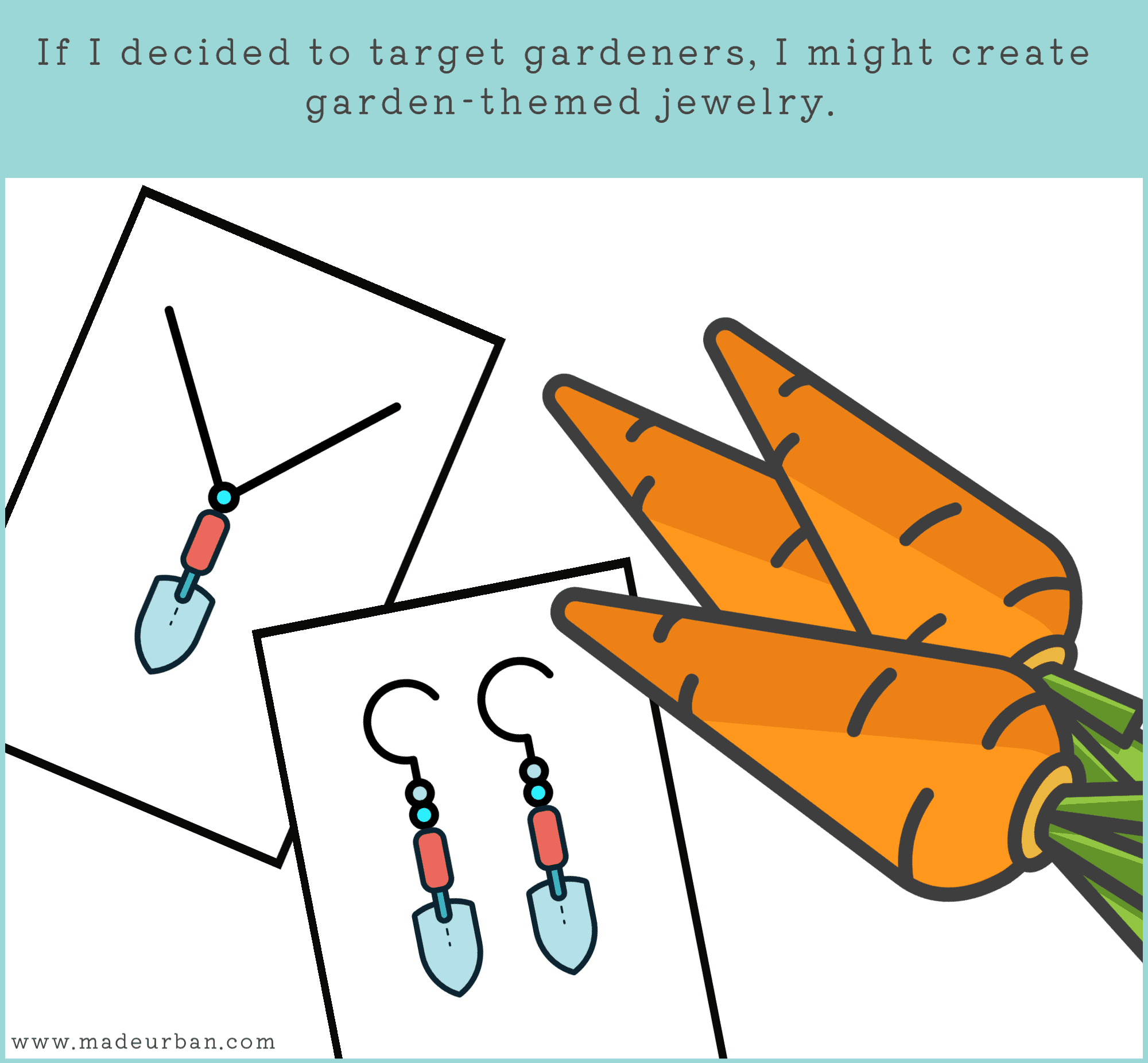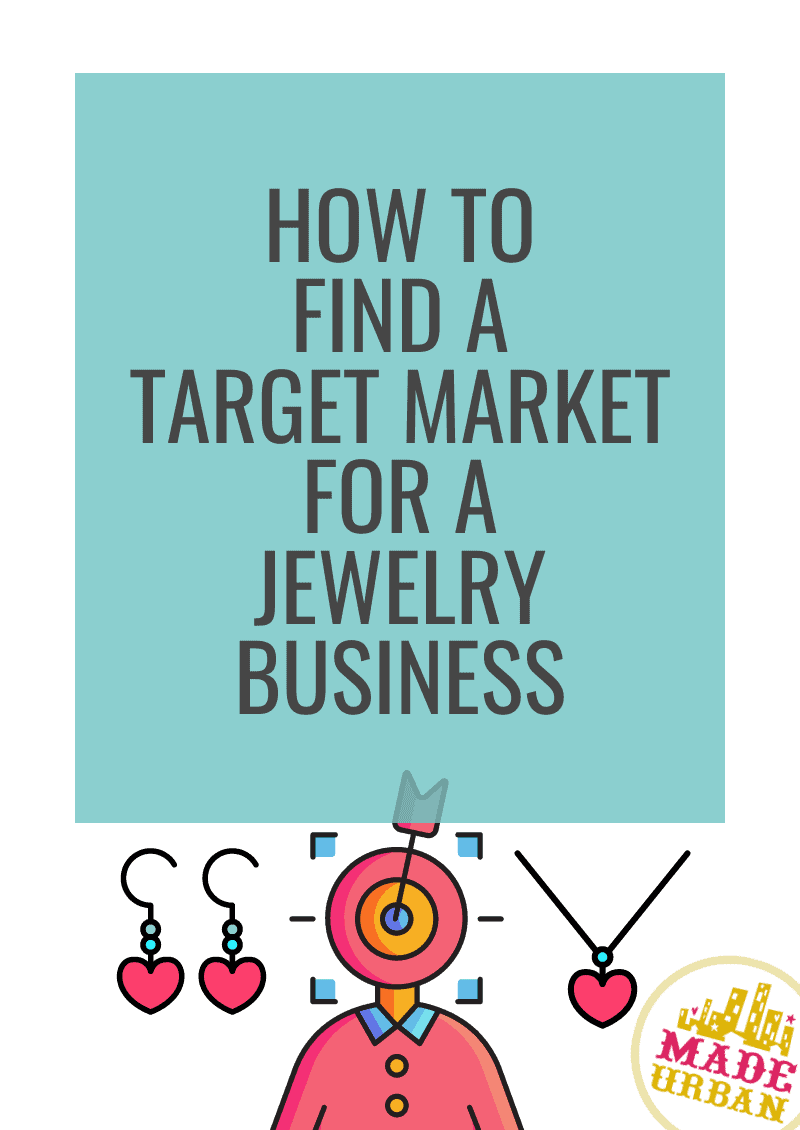How To Find a Target Market for a Jewelry Business
Starting a jewelry business without a target market in mind is sort of like planning a trip without knowing where you’re going, who you’re going with, how you’re going to get there, etc.
>> You must know the exact location you want a plane to land if you’re going to plan a trip.
>> You must know the exact customer you want to sell to if you plan to build a successful business.
Your customers are the most important part of your business; without them, you don’t have a business.
So you must know who those customers are and what they want.
This article will help you uncover that information.
Common target market mistakes
These are the 3 biggest and most common mistakes I see handmade business owners making when defining their target market.
1) Putting the cart before the horse
Almost every business decision you make should be based on your target market.
So it makes sense then that you should choose a market to target and then build a business, brand, and product tailored to them.
However, most handmade businesses start with a product. Then the business owner goes looking for people who are a match for it.
If you’ve already starting building your jewelry business without your target in mind, it’s not too late. You can’t change the people you’re selling to, but you can alter your business.
Find the right target market then start making small changes to your jewelry business so it appeals to that target market.
2) Choosing your target market based on demographics
Demographics do play a role as you need to know if you’re making jewelry for a 12 year old or a 40 year old. However, they’re not the most important factor when choosing a target market.
Demographics will help you better understand your customers, but it won’t help you:
- Find your customers – it’s difficult to find your customers in large groups and in settings that are conducive to marketing and selling when all you have are demographics to work with.
- Connect with your customers – just as we don’t connect with other individuals just because they’re the same age or gender, or because they also completed post secondary school, we don’t connect with businesses just because they’re targeting people of our age or gender.
- Create the perfect product, business, and brand for your customers – if you wanted to buy the perfect gift for someone, you need to know more than just their age, gender, location, etc. Your products are like gifts to your target market. And to create the perfect gift, you need to know more than their demographics to have a deeper understanding of them.
You can read more here if you’re wondering why I don’t recommend starting with demographics when determining your target market.
3) Not choosing from an existing market
How easy would it be for you to find people who love to work out? Pretty easy.
There are hundreds of businesses already serving those people. Athletes, body builders, runners, etc. are all target markets that exist.
And you can find them in gyms, buying products at fitness stores, reading fitness blogs and magazines, at body building competitions, races, etc.
If you make up a new target market or base your target market on the wrong information (e.g. people who love lots of color), you’re going to have a hard time finding customers.
>> A business can reach athletes in a gym, at a fitness store, through fitness magazines, etc.
>> A business can’t easily find “people who love colourful jewelry”.
Work with the target markets that already exist and that businesses are already reaching.
How to choose a target market
Now you know what not to do when choosing a target market. Here are steps to follow to help you choose the right target market for your handmade jewelry business.
Step 1 – Focus on psychographics
Psychographics are the psychological characteristics such as beliefs, values, interests, lifestyle, attitude, etc.
When choosing a target market, focusing on an interest, hobby, or lifestyle will help you uncover valuable information that will help you find your customers and effectively sell to them.
Remember, the point of this exercise isn’t to fit a square peg into a round hole.
You must be willing to adapt your business if required.
If I make jewelry, and choose gardeners as my target market, my target market information will be useless unless I alter my jewelry or business so it somehow relates to gardening.
Below are several ways you can find target markets based on psychographics.
Interests or hobbies
- Fashion (ideally a specific style of fashion such as bohemian, goth, or Y2K)
- Reading
- Crafting
- Gardening
- Baking
- History
- Sports (hockey, pickleball, golf, etc.)
- Astrology
- Animals
- Music
- Cars
- Working out
- Meditation
- Spirituality
- Etc,
Enthusiasts/enjoyment
You may also explore things that aren’t necessarily an interest but rather things people enjoy, are enthusiastic about, consider a guilty pleasure, etc.
- Family time
- Wine/beer/whisky/etc.
- Coffee or tea
- Pets
- Gambling
- Car enthusiast
- Retro enthusiast
- Nature enthusiast
- Etc,
Lifestyle
A business can also connect with a target market based on the type of lifestyle they live. For example:
- Sustainable lifestyle
- Minimalistic lifestyle
- Simple living
- Spiritual living
- Holistic lifestyle
- Etc.
Labels
You may also explore common labels people give themselves or that are given to them by others. These may not necessarily be based on an interest, but rather a defining feature that connects them with other people or businesses.
- Parent / Mom / Dad
- Student
- Entrepreneur
- Foodie
- Fashionista or trendsetter
- Beach bum
- Gamer
- Yogi
- Gym rat
- Activist
- Tree hugger
- Cat lady
- Wellness warrior
- Bookworm
- Sports fanatic
It may even be a label given to them by the medical community, such as ADHD (in which case, fidget jewelry would be an appropriate product).
Occassion or life event
There are also things that pique a consumer’s interest for a shorter period of time. For example, someone may be interested in all things wedding related when they’re planning their wedding. These types of temporary interests can also work for finding a target market.
- Weddings
- Engagement
- Birthdays
- Graduations
- Retirement
- Pregnancy / Births / Baby showers
- Baptism
- Buying a new home
Consider the ideas above “common interests” that connect the people within a target market.
For example, a person’s interest in gardening is what connects them to people, places, and things related to gardening.
Choose from the list above or explore other common interests that could work for your target market.
Step 2 – Apply the common interest to your jewelry business
Once you’ve chosen a target market based on a common interest, you want to be sure you can apply that common theme throughout your business.
Consider the different touchpoints of your business and how you can communicate the common interest you’re appealing to.
Explore:
- Product features (materials, shapes, colors, etc.)
- Product packaging
- Product names & descriptions
- Product photography
- Product lines & collections
- Shipping
- Customer service
- Business vision & mission
- Branding (brand colors, fonts, language, logo, etc.)
- Website design
- Craft show display
- Etc.
For example, if I’m targeting gardeners, I may apply that theme to my jewelry business in the following ways:
- Product features – pendants and charms in the shape of vegetables, flowers, and gardening tools.
- Product packaging – jewelry cards could be made out of seed paper that can be planted.
- Product names & descriptions – name each product using common gardening terms (e.g. Gardening trowel pendant necklace).
- Product photography – incorporate gardening-themed props into some product photos (e.g. a bundle of carrots photographed next to gardening trowel pendant necklace).
- Product lines & collections – develop collections based on common gardening categories (e.g. a root vegetable collection).
- Shipping – use biodegradable shipping materials so they can be tossed in a gardener’s compost bin. Make each shipment carbon neutral.
- Customer service – a garden theme may be applied in a simple way, such as an email auto-reply stating “I’m out weeding my garden but will reply to your email within 2 business days”.
- Business vision & mission – may serve a bigger cause of helping the planet by using biodegradable, renewable, eco-friendly materials, being carbon neutral, donating a portion of profits to community gardens, etc.
- Branding (brand colors, fonts, language, logo, etc.) – follow a gardening theme when it comes to branding.
- Website design – apply a gardening theme to my website.
- Craft show display – apply a gardening theme to a craft show booth by dressing like a gardener, using gardening tools as props (e.g. incorporating a watering can, basket of vegetables, etc.).

Step 3 – Look for marketing and sales channels
The last step before deciding on a target market for your jewelry business is to ensure you can find your potential customers, market to them, and sell to them.
If you can find other business reaching your target market, you’ll also find marketing and sales platforms for your business that put you in direct contact with your perfect customers.
For example, if I’m targeting gardeners with vegetable and flower themed jewelry, I would be able to:
- Approach garden centres, greenhouses, and flower shops to see if they would purchase my jewelry to carry in their stores.
- Contact gardening blogs about advertising my jewelry on their site or to see if they might want to feature/mention my jewelry in an article.
- Gift my jewelry to gardening influencers on Instagram.
- Send press releases to gardening magazines.
- Apply to be a vendor at home & garden trade shows and events.
There are multiple places I can reach my exact target market, which will make it easier to market and sell my gardening-related jewelry.
Can a jewelry business be successful without a target market?
Many jewelry businesses are successful without consciously choosing their target market first.
In my opinion, you need to know exactly who your customers are if you’re going to go find them.
If you want customers to come to you, then it’s important to focus on different aspects of your business such as having a strong keyword/SEO strategy, or having a signature style that stands out, or a USP (unique selling factor) that sets your business apart.
There are many ways to build a successful jewelry business.
Choosing a target market you can easily find and connect with is just one of those ways.
I hope this article helps you find a good target market for your jewelry business. Please let me know in the comment section if you have any questions.


Hey, I’m Erin 🙂 I write about small business and craft show techniques I’ve learned from being a small business owner for almost 2 decades, selling at dozens of craft shows, and earning a diploma in Visual Communication Design. I hope you find my advice helpful!
